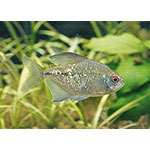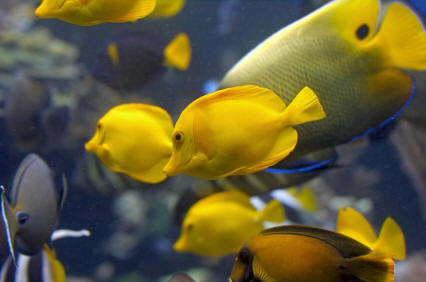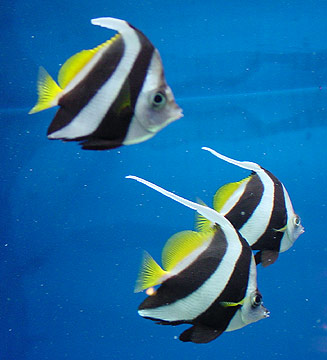Tetra Diamond

|
Scientific Name: Moenkhausia pittieri Price: Upon Request Origin: Lake Valencia, Venezuela, South American Family: Characidae NOT AVAILABLE NOW |
|
Other Names: Gymnocorymsus Ternetzi, Brillantsalmler, Diamond Characin, Pittier's Tetra, Timanttitetra |
|
Technical Info
Temperature: 24 - 28 ℃
pH: 6 - 7.5
GH: 4 - 8
Max size: 6 cm
Min Tank size: 60 Ltr
Position in Aqua: Middle swimmer
Description
The diamond tetra’s lack of color is more than made up for by its other attributes. The scales located on the sides of this fish are reflective and almost shimmer. Its overall color is a glittering silver with highlights of greenish-blue. Mature males have an elongated dorsal fin, which, when fully developed, trails almost to the tail. This fish does best in a school of at least six or eight fish, where one male will become dominant, tolerating other males but reminding them of their place behind him.
Food
Easy to feed. It will readily accept just about anything offered. For the best condition and colours offer regular meals of small live and frozen foods such as bloodworm, Daphnia and brine shrimp, along with dried flakes and granules.
Breeding
A pair of Diamond Tetras will spawn in an aquarium with an area well planted including fine leaved plants creating a well shaded area. The pair should be well conditioned before hand with rich food including live food. The tank should be darkened before and during breeding, and then the light should slowly be increased over a few days to create a natural lighting. The water should be very soft and a pH of 6 is preferable. A temperature of 28 degrees C is suitable. The fish usually spawn in the early morning. They will eat their eggs and are normally removed after spawning. The eggs normally hatch in 36 hours and the fry are usually free swimming in 4 days. The babies grow quickly. They will eat fry foods, but suitable sized live foods will help at all stages.
Compatible with
It’s a good tankmate for most livebearers, danionins, rasboras, other tetras and peaceful bottom dwellers such as Corydoras or smaller Loricariids. It can also be kept with the majority of commonly available gouramis and dwarf cichlids. Due to its rounded shape and adult size it can also be used as a dither for non-aggressive, medium-sized cichlids such as discus or Geophagus species.
Note
This species is something of an “ugly duckling”, as it’s usually sold as a fairly bland looking, silvery juvenile. Given time and a good diet it develops into a magnificent fish as an adult, that really does sparkle like a diamond. A big shoal of these in a planted tank looks stunning.

